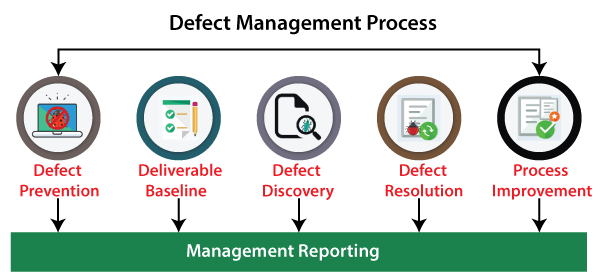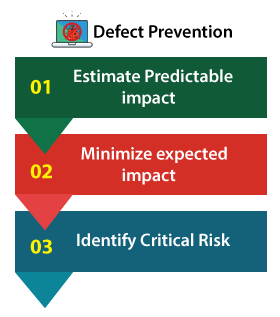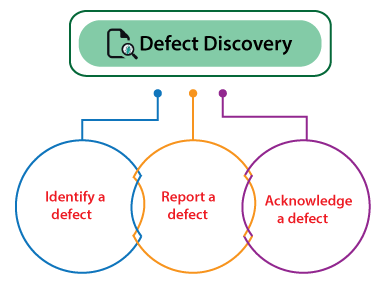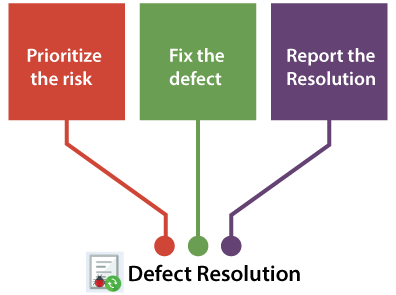Defect Management ProcessIn this section, we are going to understand the working of the Defect management process. Also, see the defect in software testing, defect management process's objective, defect management process, advantages and disadvantages of the defect management process. But, firstly, we will understand the process of defect management, and we will understand the defect in software testing. Defect in Software Testing
What is Defect Management Process?The defect management process is the core of software testing. Once the defects have been identified, the most significant activity for any organization is to manage the flaws, not only for the testing team but also for everyone involved in the software development or project management process. As we know, defect prevention is an effective and efficient way to decrease the number of defects. The defect prevention is a very cost-effective process to fix those defects discovered in the earlier stages of software processes. The Defect Management Process is process where most of the organizations manage the Defect Discovery, Defect Removal, and then the Process Improvement. As the name recommends, the Defect Management Process (DMP) manages defects by purely detecting and resolving or fixing the faults. It is impossible to make a software 100% error or defect-free, but several defects can be declined by fixing or resolving them. The defect management process primarily focuses on stopping defects, finding defects in the earlier stages, and moderating the effect of defects. The Objective of Defect Management Process (DMP)The main objective of the defect management process is as discussed below:
And for the different organization or projects the critical goals of the Defect management process is as follows:
Various Stages of Defect Management ProcessThe defect management process includes several stages, which are as follows:
Let's discuss them one by one: 
1. Defect PreventionThe first stage of the defect management process is defect prevention. In this stage, the execution of procedures, methodology, and standard approaches decreases the risk of defects. Defect removal at the initial phase is the best approach in order to reduction its impact. Because in the initial phase of fixing or resolving defects is less expensive, and the impact can also be diminished. But for the future phases, identifying faults and then fixing it is an expensive process, and the effects of defect can also be amplified. The defect prevention stage includes the following significant steps:

Step1: Estimate Predictable Impact In this step, if the risk is encountered, then we can calculate the estimated financial impact for every critical occasion. Step2: Minimize expected impact When all the critical risk has been discovered, we can take the topmost risks that may be dangerous to the system if encountered and try to diminish or eliminate it. Those risks that cannot be removed will decrease the possibility of existence and its financial impact. Step3: Identify Critical Risk In defect prevention, we can quickly identify the system's critical risks that will affect more if they happened throughout the testing or in the future stage. 2. Deliverable BaselineThe second stage of the defect management process is the Deliverable baseline. Here, the deliverable defines the system, documents, or product. We can say that the deliverable is a baseline as soon as a deliverable reaches its pre-defined milestone. Note: The Pre-defined milestone describes what the software is supposed to accomplish.In this stage, the deliverable is carried from one step to another; the system's existing defects also move forward to the next step or a milestone. In other words, we can say that once a deliverable is baselined, any additional changes are controlled. 3. Defect DiscoveryThe next stage of the defect management process is defect discovery. At the early stage of the defect management process, defect discovery is very significant. And later, it might cause greater damage. If developers have approved or documented the defect as a valid one, then only a defect is considered as discovered. As we understood that, it is practically impossible to eliminate each defect from the system and make a system defect-free. But we can detect the defects early before they become expensive to the project. The following phases have been including in the defect discovery stage; let's understand them in details:

Phase1: Identify a Defect In the first phase of defect discovery where we need to find the defects before becoming a critical problem. Phase2: Report a Defect The moment testing team identifies a defect, they need to assign known issues to the development team for further evaluation and fixing process. Phase3: Acknowledge Defect Once the test engineers' hand over the defect to the assigned developers, now it is the responsibility of development teams to acknowledge the fault and remain further to fix it if the defect is a valid one. 4. Defect ResolutionOnce the defect discovery stage has been completed successfully, we move to the next step of the defect management process, Defect Resolution. The Defect Resolution is a step-by-step procedure of fixing the defects, or we can say that this process is beneficial in order to specified and track the defects. This process begins with handing over the defects to the development team. The developers need to proceed with the resolution of the defect and fixed them based on the priority. Once the defect has been selected, the developer sends a defect report of resolution to the test manager's testing team. The defect resolution process also involves the notification back to the test engineer to confirm that the resolution is verified. We need to follow the below steps in order to accomplish the defect resolution stage.

Step1: Prioritize the risk In the first step of defect resolution, the development team evaluates the defects and arranges the fault's fixing. If a defect is more impactful on the system, then developers need to fix those defects on a high priority. Step2: Fix the defect In the second step, the developer will fix the defects as per the priority, which implies that the higher priority defects are resolved first. Then the developer will fix the lower priority defects. Step3: Report the Resolution In the last step of defect resolution, the developer needs to send the fixed defects report. As it is the responsibility of development teams to make sure that the testing team is well aware of when the defects are going to be fixed and how the fault has been fixed. This step will be beneficial for the testing team's perspective to understand the root of the defect. 5. Process ImprovementIn the above stage (defect resolution), the defects have been arranged and fixed. Now, in the process improvement phase, we will look into the lower priority defects because these defects are also essential as well as impact the system. All the acknowledged defects are equal to a critical defect from the process improvement phase perspective and need to be fixed. The people involved in this particular stage need to recall and check from where the defect was initiated. Depending on that, we can make modifications in the validation process, base-lining document, review process that may find the flaws early in the process, and make the process less costly. These minor defects allow us to learn how we can enhance the process and avoid the existence of any kind of defects that may affect the system or the product failure in the future. 6. Management ReportingManagement reporting is the last stage of the defect management process. It is a significant and essential part of the defect management process. The management reporting is required to make sure that the generated reports have an objective and increase the defect management process. In simple words, we can say that the evaluation and reporting of defect information support organization and risk management, process improvement, and project management. The information collected on specific defects by the project teams is the root of the management reporting. Therefore, every organization needs to consider the information gathered throughout the defect management process and the grouping of individual defects. Defect Workflow and StatesVarious organizations that achieve the software testing with the help of a tool that keeps track of the defects during the bug/defect lifecycle and also contains defect reports. Generally, one owner of the defects reports at each state of defect lifecycle, responsible for finishing a task that would move defect report to the successive state. Sometimes, defect report may not have an owner in the last phases of the defect lifecycle if we may face the following situation:
Defect StatesIf defects are identified throughout the testing, the testing team must manage them in the following three states:

1. Initial State
2. Returned state
3. Confirmation state
Advantages of Defect Management ProcessFollowing are the most significant benefits of the Defect management process: Confirm Resolution
Accessibility of Automation Tools
Offer Valuable Metrics
Disadvantages of Defect Management ProcessThe drawbacks of the defect management process are as follows:
OverviewIn this article, we have seen the defects in software testing, the Defect Management Process, benefits, and drawbacks. In software testing, the Defect Management Process is important as we are aware of any software written code, defects need to be tested. The process of defect management includes discovering defects in software and fixing them. The complete defect management process will help us to find the defect in the early stages and also make sure to deliver a high-quality product. The execution of the defect management process ensures that there are no further defects in the application while moving it to production. And the outcome of that will save lots of money. In agile methodology, the defect management process is specifically significant as the development sprints must also contain the involvement, participation, and action from test engineers. In any organization, the senior management should also understand and support the defect management process from the perspective of the company's betterment.
Next TopicRegression Testing
|
 For Videos Join Our Youtube Channel: Join Now
For Videos Join Our Youtube Channel: Join Now
Feedback
- Send your Feedback to [email protected]
Help Others, Please Share










